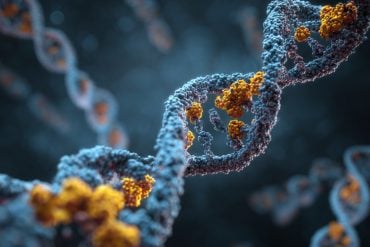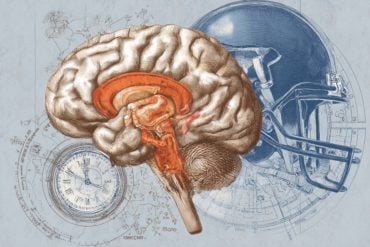Summary: Neuroimaging reveals when babies focus their attention, they utilize areas of the frontal cortex, an area of the brain associated with more advanced functions and previously believed to be immature in children under a year of age.
Source: Yale
Anyone who has watched an infant’s eyes follow a dangling trinket dancing in front of them knows that babies are capable of paying attention with laser focus.
But with large areas of their young brains still underdeveloped, how do they manage to do so?
Using an approach pioneered at Yale that uses fMRI (or functional magnetic resonance imaging) to scan the brains of awake babies, a team of university psychologists show that when focusing their attention infants under a year of age recruit areas of their frontal cortex, a section of the brain involved in more advanced functions that was previously thought to be immature in babies.
The findings were published March 16 in the Proceedings of the National Academy of Sciences.
“Attention is the gateway to what infants perceive and learn,” said Nick Turk-Browne, professor of psychology at Yale and senior author of the paper. “Attention is the bouncer at the door, determining what information gets into the brain, which eventually creates memories, language, and thought.”
Most previous research related to attention in babies has depended upon tracking their gaze while they are presented with visual stimuli, a process that theoretically offers insights into what is going on in their minds. Left unanswered are questions about which sections of the brain are involved in these responses, and how and why they allocate attention in these ways.
Attention in babies could depend upon on sensory areas of the brain, which process stimuli such as touch and visual stimuli and helps them react to the external world. These brain regions develop earlier in infancy than regions of the frontal cortex, which are usually associated with internal functions such as control, planning, and reasoning.
The ability to use brain imaging with infants allowed “us to look behind the mirror,” for the neural origins of attention, Turk-Browne said.
For the study, they used the new fMRI technology to track the neural activity of 20 babies aged from 3 to 12 months, tracking which regions of their brains were activated as they focused their attention in response to a series of images.
In a series of tests, the babies were shown a screen on which a target would appear on either the left or right side. In each case, these appearances were preceded by one of three visual cues signaling where the target would appear: on the same side that the target would appear, on both sides of the screen (thus uninformative), or on the opposite side. Researchers monitored the babies’ eye movements as they completed these tasks.

As expected, the babies were much quicker to move their eyes to the target when first presented the correct cue, confirming that the cues had focused their attention. Simultaneously, the researchers used brain imaging technology to see which areas of the brain were recruited during these tasks.
In addition to sensory areas of the brain, they found that activity also increased in two areas of the frontal cortex, the anterior cingulate cortex, and the middle frontal gyrus, areas of the brain that when fully developed are involved in controlling adult attention.
“This doesn’t mean these regions play the same role in babies as in adults, but it does show that infants use them to explore their visual world,” said Cameron Ellis, a Ph.D. candidate in psychology at Yale and first author of the paper.
Studying how the brain is enlisted during development “will help researchers uncover the foundations of human learning, which could one day help improve early-childhood education and reveal the roots of neurodevelopmental disorders,” Ellis said.
Other authors on the study are Yale graduate students Lena Skalaban and Tristan Yates.
About this brain development research news
Source: Yale
Contact: Bess Connolly – Yale
Image: The image is in the public domain
Original Research: Closed access.
“Attention recruits frontal cortex in human infants” by Cameron T. Ellis, Lena J. Skalaban, Tristan S. Yates, and Nicholas B. Turk-Browne. PNAS
Abstract
Attention recruits frontal cortex in human infants
Young infants learn about the world by overtly shifting their attention to perceptually salient events. In adults, attention recruits several brain regions spanning the frontal and parietal lobes. However, it is unclear whether these regions are sufficiently mature in infancy to support attention and, more generally, how infant attention is supported by the brain.
We used event-related functional magnetic resonance imaging (fMRI) in 24 sessions from 20 awake behaving infants 3 mo to 12 mo old while they performed a child-friendly attentional cuing task. A target was presented to either the left or right of the infant’s fixation, and offline gaze coding was used to measure the latency with which they saccaded to the target.
To manipulate attention, a brief cue was presented before the target in three conditions: on the same side as the upcoming target (valid), on the other side (invalid), or on both sides (neutral).
All infants were faster to look at the target on valid versus invalid trials, with valid faster than neutral and invalid slower than neutral, indicating that the cues effectively captured attention. We then compared the fMRI activity evoked by these trial types.
Regions of adult attention networks activated more strongly for invalid than valid trials, particularly frontal regions. Neither behavioral nor neural effects varied by infant age within the first year, suggesting that these regions may function early in development to support the orienting of attention.
Together, this furthers our mechanistic understanding of how the infant brain controls the allocation of attention.






